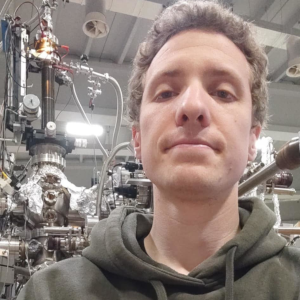Overview
The 2D spintronics team is developing the large area growth of 2D materials by molecular beam epitaxy (MBE). Our aim is to study fundamental magnetic and spin transport properties of 2D transition metal dichalcogenides down to the monolayer limit or in van der Waals heterostructures. The main research topics are two-dimensional magnetism, spin-charge interconversion phenomena, magnetic doping and the integration of 2D materials in devices. The strength of the team relies on its long experience in the physics of 2D materials and on a unique (in France and Europe) MBE platform to grow 2D materials and vdW heterostructures on large area.
Research topics
2D magnets
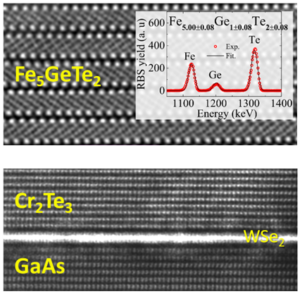
MBE growth of 2D ferromagnets and fundamental study of two-dimensional magnetism: effects of low-dimensionality (down to one monolayer) and low symmetries, manipulation by electric field and strain, proximity effects, topological effects, new spin textures (ex. skyrmions).
Spin-charge interconversion
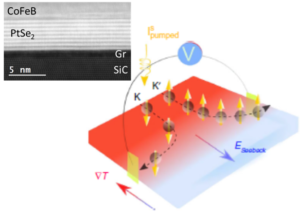
Fundamental study of spin-charge interconversion phenomena in 2D materials and van der Waals heterostructures using spin pumping, THz spintronic emission and spin-orbit torques.
Magnetic doping
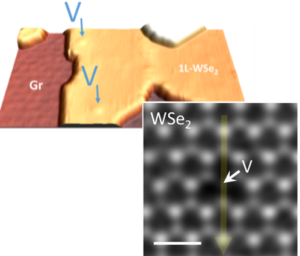
Development of magnetic and electrical doping to synthesize 2D diluted magnetic semiconductors (DMS) or to reach electronic bands with specific spin texture.
2D material integration
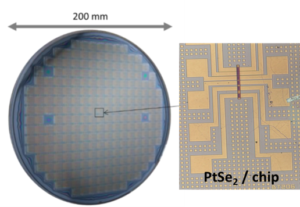
Integration of 2D materials in RF transistors, RF switches and memristors. Optimization of carrier mobility and electrical switching processes.
The team
Former members
Post-docs
- Minh-Tuan DAU (2016-2018)
- Emilio VELEZ-FORT (2019-2020)
- Mario RIBEIRO (2020-2021)
- Jules COURTIN (2022)
- Vincent POLEWCZYK (2023)
PhD
- Fabien RORTAIS (2013-2016)
- Thomas GUILLET (2017-2020)
- Quentin GUILLET (2020-2023)
- Khasan ABDUKAYUMOV (2020-2023)
Internships
- Takeo KOIKE (Sept.-Nov. 2017)
- Mohamed Husein (Mar.-Aug. 2022)
Projects
- ANR COME ON (2023-2025)
- ANR ELMAX (2021-2023)
- ANR-DFG MagSta2D (2023-2025)
- ANR NEXT (2024-2026)
- PEPR Microélectronique ADICT (2023-2027)
- Equipex 2D MAG (2021-2028)
- H2020 Graphene Flagship (-2023)
- H2020 EIC Pathfinder PLASNANO (2023-2025)
- H2020 FET-OPEN NANOPOLY (2018-2022)
- FLAG ERA MNEMOSYN
- ANR MAGICVALLEY (2018-2021)
- ANR GEMO (2008-2010)
- RTRA IMAGE (2009-2011)
- ANR SiGeSPIN (2014-2017)
- ANR MoS2ValleyControl (2015-2017)
- ANR TOP-RISE (2017-2020)
- Projet Phare CEA DRF-DRT 2D Factory (2015-2019)
- Projet CARNOT H2D3D (2017-2019)
Partners
- IRIG/PHELIQS, MEM, SYMMES, Grenoble, France
- CEA LETI, Grenoble, France
- Laboratoire Albert Fert, Palaiseau, France
- Institut NEEL, Grenoble, France
- Laboratoire Charles Coulomb, Montpellier, France
- Laboratoire de Physique de l’ENS, Paris, France
- LPCNO, INSA, Toulouse, France
- IJL, Nancy, France
- LPS, Orsay, France
- LNCMI, Toulouse, France
- Politecnico di Milano, Milan, Italy
- Forschungszentrum Jülich, Germany
- ICN2, Barcelone, Espagne
Recent news
- 24 months postdoc position – 2D ferromagnets (January 26th, 2021)

In the frame of the French national ANR project ELMAX, Spintec laboratory is opening a postdoctoral researcher position. The candidate will work on the magnetism of FeGeTe 2D ferromagnets grown by molecular beam epitaxy. The ... - ELMAX – An ANR project (January 25th, 2021)

ELMAX stands for ELectrical Control of Magnetization in fully epitaXial van der Waals heterostructures. It is a 36 months young researcher project funded by the French ANR. The recent discovery of 2D magnets has enabled ... - Highlights of SPINTEC research in 2020 (December 10th, 2020)

The research highlights of SPINTEC over the year 2020 have been put together, and are available to download: https://www.spintec.fr/spintec-annual-booklets. This booklet contains the key facts of the lab over the period (contracts, new staff etc.), the ... - PhD defense – Utilisation du couplage spin-orbite dans le germanium pour la génération, la détection et la manipulation du spin. (September 16th, 2020)

Vendredi 16 Octobre 2020 à 14H00, Thomas Guillet soutiendra sa thèse, intitulée : Utilisation du couplage spin-orbite dans le germanium pour la génération, la détection et la manipulation du spin Lieu : CEA, Bat 10.05 auditorium 445 ... - Masters thesis projects for Spring 2021 (September 15th, 2020)

You find here the list of proposals for Master-2 internships to take place at Spintec during Spring 2021. In most cases, these internships are intended to be suitable for a longer-term PhD work. Interested Master-1 ...
Publications
For the full list of publications See the personal webpage of Matthieu JAMET, Alain MARTY and Céline VERGNAUD.






